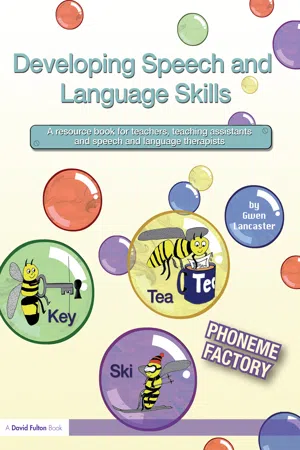
- 6 pages
- English
- ePUB (mobile friendly)
- Available on iOS & Android
eBook - ePub
About this book
This book is part of the Phoneme Factory Project undertaken by Granada Learning in partnership with the Speech and Language Therapy Research Unit (SLTRU) in Bristol.
It aims to provide guidance for teachers, SENCos, SLTs and parents regarding:
- criteria for referral to speech and language therapy
- phonological disorders
- appropriate intervention approaches that can be used in the classroom and at home.
Complementing the book are downloadable resources including a picture library for the classroom and the home, as well as checklists and other time-saving documents.
Frequently asked questions
Yes, you can cancel anytime from the Subscription tab in your account settings on the Perlego website. Your subscription will stay active until the end of your current billing period. Learn how to cancel your subscription.
At the moment all of our mobile-responsive ePub books are available to download via the app. Most of our PDFs are also available to download and we're working on making the final remaining ones downloadable now. Learn more here.
Perlego offers two plans: Essential and Complete
- Essential is ideal for learners and professionals who enjoy exploring a wide range of subjects. Access the Essential Library with 800,000+ trusted titles and best-sellers across business, personal growth, and the humanities. Includes unlimited reading time and Standard Read Aloud voice.
- Complete: Perfect for advanced learners and researchers needing full, unrestricted access. Unlock 1.4M+ books across hundreds of subjects, including academic and specialized titles. The Complete Plan also includes advanced features like Premium Read Aloud and Research Assistant.
We are an online textbook subscription service, where you can get access to an entire online library for less than the price of a single book per month. With over 1 million books across 1000+ topics, we’ve got you covered! Learn more here.
Look out for the read-aloud symbol on your next book to see if you can listen to it. The read-aloud tool reads text aloud for you, highlighting the text as it is being read. You can pause it, speed it up and slow it down. Learn more here.
Yes! You can use the Perlego app on both iOS or Android devices to read anytime, anywhere — even offline. Perfect for commutes or when you’re on the go.
Please note we cannot support devices running on iOS 13 and Android 7 or earlier. Learn more about using the app.
Please note we cannot support devices running on iOS 13 and Android 7 or earlier. Learn more about using the app.
Yes, you can access Developing Speech and Language Skills by Gwen Lancaster in PDF and/or ePUB format, as well as other popular books in Education & Education General. We have over one million books available in our catalogue for you to explore.
Information
Part 1
Background information
about speech impaired
children and how to help
them in the classroom
1
Working with children with speech
impairments in schools
An introduction to the nature of speech impairments and how teaching staff and speech and language therapists (SLTs) can work together effectively
Introduction
Speaking and listening skills are fundamental to all types of social interaction, intrinsic to many leisure activities, necessary for most types of work and essential to all aspects of education. Given how important they are, these skills are still often taken for granted. We do not usually think about how we communicate. It is as instinctive as walking. This is because most of us acquired language as a natural part of development during childhood, and most of the children we teach have acquired these skills easily too.
It is estimated that about one in ten children have difficulties in acquiring speech and language skills, however, so in most schools there will be children who need help with the development of language skills. Of these children about one in six have difficulty with speaking intelligibly. Some are just like most other children in the class – keen to talk and with no other obvious problems, but it is hard to understand what they are saying. These children may benefit from the ideas and activities provided in this book and the associated Phoneme Factory software.
Speech and language and the National Curriculum
The ‘speaking and listening’ curriculum
Providing children with opportunities to develop their spoken language abilities is part of the National Curriculum in England and Wales. Spoken language is rightly viewed as a different domain from written language. Frameworks for questions, comments, discussion, reflection and the expression of emotion, opinions and needs are very different in spoken and written language. Children benefit from becoming aware of the various ways language is used orally, so that they can learn strategies for telling stories, presenting information clearly and interacting with different audiences.
The literacy curriculum
Learning to read and write an alphabetic script such as English depends on intact underlying speech and language skills. Children with speech impairments may be slower than their peer group in grasping the fundamentals that are part of the early literacy curriculum. The ability to think about the syllables and sounds in spoken words, as required in the literacy strategy at age four to five, may not be developed until much later in children with speech impairments, and they are therefore at risk of having literacy difficulties.
The broad curriculum
Children are expected to begin the Foundation stage of education with the ability to follow verbal instructions, and speak clearly. This is important because all aspects of the curriculum depend on children having the ability to understand and use language.
Children who have difficulty making themselves understood are disadvantaged across the whole curriculum, not just in the speaking, listening and literacy components. The ability to speak intelligibly is also necessary as children develop relationships with peers through verbal interactions and co-operative play.
The social curriculum and wider context
There is evidence that children with speech, language and communication impairments are more likely to have psychological, behavioural and emotional problems. They tend to have lower self-esteem, and are perceived less favourably by their peers. This is the case even when difficulties are relatively mild. Several recent studies have shown that even when speech and language difficulties have apparently been resolved, a poorer performance in speech, language and literacy skills is sometimes still evident in adolescence and into adulthood.
What is a speech impairment?
The child with a speech impairment is usually conspicuous because of the way he or she talks. Here are some examples. Just read the written words spoken by the child in the speech bubbles normally and you will probably get the message.

Ravi

Josh

Emily
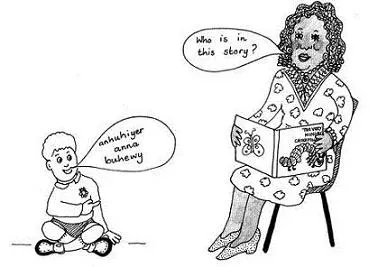
Harry
Despite the lack of clear speech, it is possible to interpret what these children are saying and respond, because the adult has clues from the context. These include the expectation of what the child is likely to say, and the here-and-now situation. The adult has contextual clues.
When contextual clues are not available, it is much more difficult to understand these children as you can see in these illustrations.

‘Kai kicked Jane’ or ‘Ty kicked Shane’, etc.
Ravi
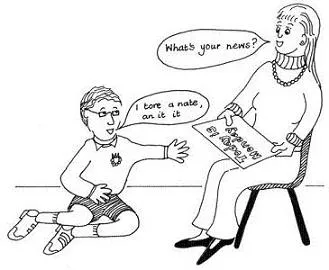
Josh
‘I saw a snake and it hissed’

Emily
‘House for my doll’
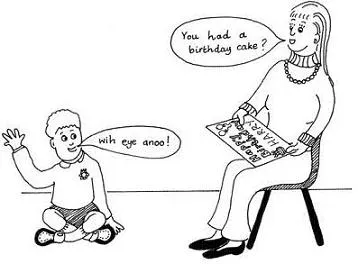
Harry
‘With five candles!’
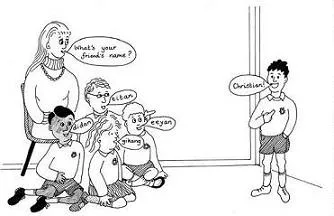
All four children
The nature of the difficulty
In all the above cases the children are substituting sounds and/or missing some sounds completely. These are usually not random substitutions or omissions, however. With careful analysis of the speech of these children, patterns can be found.
The first two children, Ravi and Josh, use developmental error patterns that are often found in younger children but not usually in those of school age. Children who persist in using such patterns have delayed phonological development. Developmental error patterns are described in Chapter 4.
The second two, Emily and Harry, use some patterns that are found in typically developing children, but they also use non-developmental error patterns, those not found in typically developing children. Children such as these are likely to need the advice of an SLT for speech assessment, diagnosis and planning intervention.
The phonological system
The acquisition of intelligible speech is not just about learning to say sounds. Children need to learn how sounds are organised in the language. The resources in this book are designed for use with children who have difficulty developing the complete system of sound contrasts that are needed to be intelligible speakers. The phonological system of English is described in detail in Chapter 2.
Articulation and phonological development
Some children with speech impairments do have difficulty with the actual articulation of speech sounds. These children will need additional help in learning how to produce the problem sounds. The resources in this book will help the child with listening and discrimination of problem sounds, but the guidance of an SLT will usually be required to help them produce the problem sounds.
Developmental dyspraxia of speech
A small minority of children have difficulty with planning and co-ordinating the movements of the tongue, lips and other speech organs. Again these children need additional resources to those provided in this book to help them develop intelligible speech.
Additional language and learning difficulties
Children like Ravi, Josh, Emily and Harry may or may not have other language and learning difficulties. The intelligibility difficulty may be the first thing that is noticed by teaching staff, but children with speech impairments often have other language problems, including delayed development of verbal understanding and expressive language. Monitoring these other skills is particularly important in this group. The Foundation stage profile can help to identify children with additional communication problems and learning needs until the end of the Reception year. Sometimes additional language problems in children who have speech impairments only emerge when children are in Key Stage 2 or 3, so it is recommended that monitoring of language skills is continued, and referral to a specialist language teacher or SLT is made if concerns about their progress are noted at a later stage.
The risk for literacy difficulties
Children with speech and language difficulties are, as a group, generally at risk of having literacy problems. Some children with early speech and language impairments develop phonological awareness, but they do this more slowly than their peers. They are delayed in development. These children might underachieve because they were not ready to learn when the necessary teaching was available. They are not fundamentally at risk of reading difficulties, but the teaching they need has bypassed them. These children are likely to need specific intervention packages as part of the Literacy Strategy guidelines produced by the Department for Education and Skills (DfES 2002).
Other children with speech impairments who are likely to be at risk can potentially be identified earlier. These include children who have non-developmental error patterns such as Emily and Harry.
For more information about typical development of speech and definitions of speech impairments, see Chapter 4.
Teaching staff and speech and language therapists working together
Children with speech and language impairments can be helped to develop most effectively when teaching staff and SLTs work collaboratively. The DfES (2001) Code of Practice for Special Educational Needs and the Royal College of Speech and Language Therapists’ (RCSLT 2006) guidelines for service delivery to education both recommend collaborative practice. References to current legislation, curriculum advice and RCSLT guidelines are provided in the bibliography.
Special educational needs (SEN)
Children with speech impairments have a spe...
Table of contents
- Cover Page
- Title Page
- Copyright Page
- Foreword
- Acknowledgements
- About Phoneme Factory
- Introduction: Is This the Resource I Am Looking for?
- Part 1: Background Information About Speech Impaired Children and How to Help Them In the Classroom
- Part 2: Practical Activities to Use With Children With Speech Impairments
- Glossary
- References, Bibliography and Further Reading